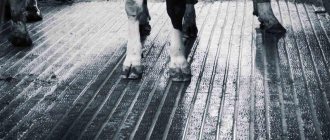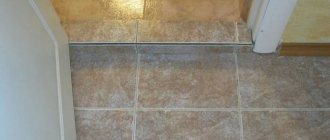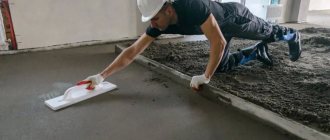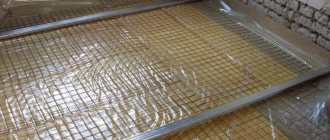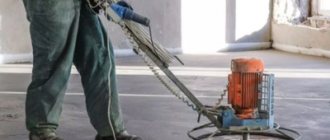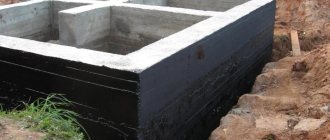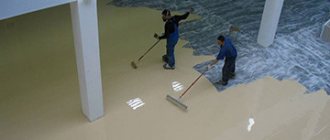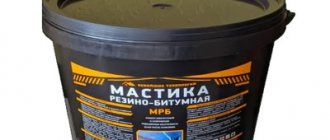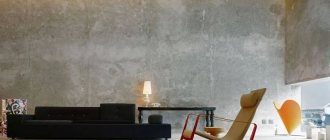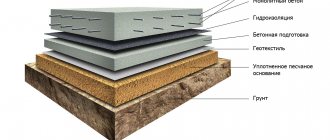The pleasure of living in a cozy home begins with renovation. This is a long and costly process that requires attention and responsibility at all stages of the work. One of these stages is waterproofing the floor before screeding.
As you know, pouring screed is one of the most time-consuming components of a good repair. It does not forgive mistakes, you will have to redo everything again, so it is very important to do even the most insignificant work correctly.
Waterproofing the floor under the screed
Video - Waterproofing a floor under a screed
Types of waterproofing materials and methods of their installation
The construction market offers a wide selection of waterproofing materials. At the same time, in each technological group there is diversity in both price and quality characteristics. Therefore, it is very difficult to make a choice on your own.
Based on insulation technology, all materials can be divided into:
- Rolled ones, which in turn are:
- Pasting - attached to the base of the floor and to each other, with multi-layer insulation, using bitumen mastic;
- Fused when one side of the material is impregnated with an adhesive composition, covered with a protective film. Heating the roll with a special gas burner from the protection side leads to its melting and opening of the adhesive layer;
- Polymer joints are heated with a construction hairdryer and glued together.
- Liquid application materials (coating mastic, liquid rubber, etc.);
- Penetrating primers;
- Dry plaster mixtures of binder type.
Roll insulation
The presence of many types of roll waterproofing is explained by the large number of combinations between the main layer of material and the types of insulating agent. The basis may be:
- Fiberglass. Budget-friendly in price, it has a short service life;
- Fiberglass. The cost of the material is several times higher, but this is justified by the increase in strength and durability by 5 times compared to the first option;
- Polyester materials. Having the same strength as fiberglass, they are 4-5 times more elastic, which allows them to maintain excellent adhesion to the base of the floor during temperature fluctuations;
- Cardboard. Builders are gradually abandoning such materials when waterproofing the lower parts of a building due to their fragility;
- Foil;
- Asbestos paper. It is practically not used for waterproofing under screed.
Waterproofing layers are applied:
- bitumen:
- butyl rubber (rubber compounds);
- tar.
For example, roofing felt is a mixture of bitumen and construction cardboard. Replacing bitumen with tar produces a material familiar to the older generation - roofing felt. Applying a bitumen layer to fiberglass allows you to obtain waterproofing, glass roofing material, glass felt, etc. Industrial rubber mixtures produce multi-layer, but without a base, hydrobutyl and other materials.
In addition, polyethylene film is classified as a separate group of roll materials. The variety of types of materials predetermined several technologies for their installation.
Pasting method of laying waterproofing
All technologies for laying various types of waterproofing under screed begin with careful preparation of the base. This process is discussed in detail in the work “Preparation of the base for floor screed”, posted here. Therefore, when considering all waterproofing technologies, the initial stage of work will be omitted.
The subsequent work on laying waterproofing with your own hands consists of the following steps.
1. The concrete floor is treated with a primer - a primer for concrete made on the basis of bitumen. This will ensure the necessary adhesion of the bitumen mastic to the base of the floor.
Primer treatment.
2. Damper tape is attached to the walls along the entire perimeter using an adhesive layer or liquid nails. Its purpose is to allow the screed to expand without damage during temperature fluctuations.
Laying damper tape.
3. The rolled material is cut, and along the way it is cleaned of powder and dust. In this case, it is necessary to take into account:
- this technology requires at least two layers of material;
- the material should extend onto the walls by 15 cm (after laying the screed, the excess is cut off);
- overlapped by 15-20 cm;
- in places adjacent to the threshold, leave at least 30 cm so that the insulating material can enter the next room.
4. The cut material is rolled out and left in this position for a day, which will allow you to avoid waves and bubbles when gluing.
5. The next day, the places of contact of the waterproofing material with the base of the floor and walls are treated with bitumen mastic.
Important: cold mastic is applied in one layer 1 mm thick, hot mastic in two layers. The second layer must be applied after 3-4 hours so that the first layer does not have time to dry completely.
6. The first sheet of insulation is laid and carefully pressed against the walls and base of the floor with a rubber wallpaper roller.
7. When treating the base for the second sheet with mastic, also glue the joint on the first sheet, where an overlap is formed.
8. After laying the first layer, it is tapped to identify unglued areas.
9. The resulting waves and bubbles are cut crosswise, leveled, coated with mastic and again attached to the base. The incision areas are dried and coated with mastic. An overlapping patch is applied on top.
10. The second layer is laid in the same order. The only thing that needs to be taken into account is that the joints of the second layer should lie approximately in the middle of the sheets of the first layer.
This method of installing insulation is relatively inexpensive, reliable, has a long service life (at least 18 years), is not damaged when cracks form in the base of the floor, and can be done on your own.
Disadvantages include high labor intensity, long installation time, and a high degree of fire hazard.
Welded method
Waterproofing floor screeds using the fused method is a new, highly effective method of protection against moisture. The material is laid in one layer, and the overlap does not require primer treatment. The first steps of the technology repeat points 1-4, with the exception of sub-point 3.1, the pasting method.
Further work with this type of materials is determined by their structure. Fused waterproofing is based on fiberglass impregnated with polymer materials. The top layer performs protective functions, and the bottom serves as glue. To prevent rolls from gluing, the adhesive base is covered with a special protective coating.
Before installation, the material is rolled again. The protective film is heated with a gas burner until the control mark disappears. As the adhesive layer warms up, the roll is rolled out and laid at the same time.
The surface of the laid material is rolled with a roller to ensure a tight fit to the base, without the formation of bubbles. The second sheet is also overlapped, as in the previous method. The work is done quickly.
This method also has disadvantages:
- cannot be laid on a wooden floor due to possible fire when using an open flame;
- high price of the material compared to roofing felt;
- the work can be performed by builders who have experience in installing insulation in this way;
- The laying technology is designed for 2 people.
Method for gluing joints of polymer materials
This method completely repeats the previous one, with the exception of one thing - it does not provide for adhesion of the waterproofing material to the base of the floor.
The sheets are laid overlapping, and the joints are welded using a special construction hair dryer.
The essence of the technology is clearly visible in the photo.
Important: all rolled materials simultaneously perform the function of sound insulation. The use of other types of waterproofing materials requires sound insulation.
Mastic
Coating waterproofing mastics are liquid insulating materials based on bitumen, rubber, polymers or a mixture thereof. For example, bitumen-rubber, bitumen-polymer, etc. mastics. Apply with a paint brush or roller, similar to paint.
The work is performed in the following sequence.
1. The prepared concrete floor is treated with a primer, preferably the same brand as the mastic. In addition, the walls around the entire perimeter are subject to treatment. The height of the strip applied to the wall is 15-20 cm. A roller and brush are used for application. You will need a brush to work on areas that are inaccessible to a roller, such as the space around pipes, corners, and joints of walls and ceilings. The primer is applied in one layer over the entire surface, without missing spots. Dries in no more than 2 hours.
2. A damper tape is attached around the perimeter of the walls (this operation can be performed before laying the screed).
3. Using a wide brush, roller and spatula (it makes it easier to process the joints between walls and ceilings), apply the first layer of mastic. Work begins with the wall farthest from the exit. All hard-to-reach places are thoroughly coated. There is no need to rub in the mastic by force. Each layer is applied in one direction, at the same time perpendicular to the previous one.
4. The next layer is applied to the previous one after 3-4 hours. If you let the mastic dry, it will polymerize and the next layer will simply fall behind. In total, the insulation is applied 3-5 times. Complete drying of the coating insulation occurs after two days.
The advantages of the method include:
- reliability;
- ease of installation - no experience or many tools and equipment required;
- environmental Safety;
- durability;
- the ability to treat hard-to-reach places.
There are several, but very significant, disadvantages:
- cannot be used in houses with constant vibration - near a highway, railway or construction site - mastic loses its insulating properties;
- insulation is not resistant to sudden temperature changes;
- is easily damaged mechanically, and therefore, when reinforcing the screed with a metal mesh, special polymer gaskets are placed under it.
Important: such waterproofing of the floor under a screed in an apartment is effective in residential premises. In the bathroom, kitchen and toilet there should be a combined method - rolled waterproofing materials are laid on top of the mastic, which gives a 100% guarantee of the quality of the work performed.
Penetrating primers
The introduction of new technologies into production has not spared the construction industry. Penetrating waterproofing is one of them. The essence of the new waterproofing method is to change the physical structure of concrete under the influence of impregnation components.
By reacting with concrete binders, they create a protective film of insoluble crystals that clog all microcracks and pores to a depth of 0.5 mm. In addition to protection from water, such a film increases the resistance of concrete products to aggressive chemicals.
Penetrating waterproofing primer is available in liquid form - "Penetron", "Pronitrate" and in the form of dry mixtures - "Kema". How to waterproof with a penetrating primer?
- The concrete surface is abundantly wetted, but leaks should not be allowed to the neighbors below.
- Dry mixtures are diluted according to the instructions on the package.
- Immediately before applying the penetrating primer, the surface is wetted again.
- The first layer of insulation is applied with a roller or brush.
- After the time specified in the instructions, a second layer of primer is applied to the newly moistened concrete.
- The treated area is covered with plastic wrap or moistened regularly for 2 weeks.
- After complete drying, waterproofing of the wall is carried out along the entire perimeter at a height of 15-20 cm from the base of the floor and joints with mastic using a wide paint brush.
The advantages of the new technology include the fact that the waterproofing protection carried out:
- has no restrictions on service life;
- withstands any mechanical loads;
- has the ability to tighten microcracks that arise during operation.
There are quite a lot of disadvantages:
- impregnating primer is not effective on concrete with a low grade of cement;
- cannot be applied to brick, gypsum and lime plaster, which requires treating such materials with mastic;
- very high price;
- long technological cycle.
Conclusion: the use of penetrating primer in residential construction is ineffective. Penetrating primer was originally created for waterproofing large areas.
Plaster mixtures
Plaster waterproofing mixtures consist of sand, cement and polymer components that provide protection from moisture. Unlike penetrating primer, it can be applied to any building materials:
- brick;
- concrete;
- gypsum and lime plasters.
This waterproofing has a high level of adhesion (adhesion) to the surface and a low coefficient of elasticity, which allows it to be applied in rooms with high temperature differences - from -50 to +70 degrees C.
Work order:
- The mixture is diluted with water to form condensed milk.
- Apply a thin layer to the prepared surface with a spatula.
- After the first layer has dried, a second layer is applied within 15 minutes in the direction opposite to the first.
- The third and, if necessary, the fourth layer is applied in the same way.
- Drying occurs within 2 weeks, but in the first 5-7 days the surface of the plaster must be moistened: every 4-5 hours using aerosol cans (spray guns) for the first 24 hours; 2-3 times in the next 4-6 days.
This technology does not require large financial costs, is performed with one simple tool, has a long service life, and the work can be done on one’s own. The only downside is that it takes a very long time to dry.
We have reviewed the main types of waterproofing. However, there are no less effective, but not very popular types of protection against water - liquid glass, cast (liquid) rubber, bulk polymer mixtures, etc.
Attention: waterproofing the floor after screed is only possible with rolled materials due to the damper tape (neither mastic nor plaster mixtures will adhere tightly to the tape and, therefore, there will be no insulating layer at the junction of the wall and the screed).
What is a screed
A screed is a set of measures aimed at final leveling the floor surface for the subsequent application of a decorative coating. It can be done in different ways. The type of method used depends on the features of the structure and the design as a whole.
The following types of screed are known:
- self-leveling;
- concrete;
- dry.
Cement floor screed
The simplest and most practical is considered to be a screed with a self-leveling effect. It is performed using special building mixtures. The finished solution is applied in a thin layer, no more than 30 mm, to the surface of the floor or slab, forming a perfectly flat plane. This screed is suitable for all types of finishing coatings.
The traditional method of making floors in apartments and houses is concrete processing. With it, it becomes possible to eliminate significant differences in the surface, as well as protect floors from moisture.
Floor design
In a situation where there are significant deviations and unevenness of the floor from the horizontal, within 30..120 mm, you cannot do without a dry screed. It is fundamentally different from the other two methods, since it additionally uses gypsum fiber and sheets laid on the logs.
It is important to do the screed both in apartments of multi-storey buildings directly on the bottom slab, and in individual private buildings. There is no better alternative for arranging the base of the floor. In particular, in panel buildings the walls and ceiling are quite smooth, since they are made of slabs, but the floor is far from ideal. Its untreated surface is not suitable for laying a finishing coating. The situation with private houses may be different, but there additional waterproofing is done under the screed and after the screed.
Features of waterproofing apartments and country houses
Differences in waterproofing technology for a private house and an apartment appear only when installing a sand and gravel base for the floor. If concrete floors are used in a cottage or country house, there are no differences in the procedure for performing protective work between an apartment and a residential building.
How to properly lay a subgrade for a floor is shown here. Next steps are as follows:
- the soil is covered with geotextile to protect rolled waterproofing materials from mechanical damage;
- Rolled waterproofing is installed.
The lifespan of a new floor is determined by many factors. But its protection from moisture is decisive. All types of floors, except ceramic floor tiles, are actively subject to irreversible changes under the influence of open water or its vapors in the air.
Screeding the floor of a private house
Of course, wooden and concrete floors of houses, without appropriate waterproofing, may be at risk of the harmful effects of capillary moisture. Therefore, increased attention is paid to their protection.
The undesirable influence of groundwater on building components can be avoided by laying a sand and gravel cushion, onto which roll waterproofing is additionally applied. According to existing standards and requirements, the specified protection is additionally applied to walls or slabs up to 100 mm, after which the screed is poured.
Let us add that in private households it is recommended to do proper floor screeding in absolutely all rooms for any purpose.
Waterproofing the floor with a penetrating compound
Before starting installation, it is necessary to initially prepare the surface accordingly. An air cushion is created from elements that differ in their density and composition:
- pouring crushed stone with a height of at least 100 mm;
- final addition of dry sand to the marked mark.
Emphasis should be placed on the high-quality formation of an air cushion, since it plays the role of an effective barrier to capillary water. The air pockets provided have a height and base structure that proves difficult for water to pass through.
In places where groundwater lies quite close to the ground, unfortunately, it will not be possible to get by with just one “cushion”. Such situations require the production of additional waterproofing of the floor, treatment of walls or slabs. For these purposes, a simple polyethylene film is suitable, ideally coping with its task. The technology presented has proven itself in terms of availability and durability. Naturally, there are many alternatives to it, but they are more expensive in price.
Cost of materials for waterproofing
| Name | price, rub. | Price for 1m2, rub. |
| Hydroisol based on steklohost, 2.5 mm, 9 sq. m. | 400 | 45 |
| Uniflex TechnoNIKOL, 3 mm, 10 sq. m. | 1200 | 120 |
| Ruberoid, 15 sq. m. | 400 | 27 |
| Technoelast TechnoNIKOL, 4 mm, 10 sq. m. | 1400 | 14 |
| Aquastop - Perfecta, 20 kg (coating) | 650 | 130 |
| WaterStop SLIMS, 20 kg | 850 | 190 |
| Mastic Flachendicht, Knauf, 5 kg | 1250 | 227 |
| Bitumen mastic, 20 kg | 350 | 70 |
| Rubber mastic, 22 kg | 1350 | 60 |
| Construction bitumen, 25 kg | 600 | 50 |
| Bitumen primer, 20 l | 650 | 65 |
| Bitumen primer TechnoNIKOL, 20 l | 1800 | 27 |
Advice from professionals
- Waterproofing technology can vary depending on the type of room. So, when installing a concrete floor in a bathhouse, it is worth planning its slope. Thus, a passive waterproofing is formed with the possibility of water flowing into the drain. It is also worth more reliably sealing the joints and tie-ins of communications.
- All formulations should be diluted strictly according to the instructions on the jar.
- When laying roll waterproofing, one must not forget about coating the joints and edges of defective areas. Also, you can’t skimp on the overlap of the canvases on each other. And if one leaf leaves, it is necessary to trim and spread a new one.
- To enhance strength, the top layer of waterproofing can be sprinkled with quartz sand, having previously treated it with mastic.
- It is worth starting work with coating waterproofing from the far corner of the room. Also, the applied layer should not grow above 2 mm.
- Any construction work during the period of drying of the layer using the coating method should be suspended, since the ingress of dust, moisture or dirt will significantly reduce the protective functions.
Protecting a concrete base means extending the life of not only its functionality, but also the top floor, decorative coating and the building as a whole. And if you choose the right waterproofing method and strictly follow the application technology, performing waterproofing will not be difficult.
